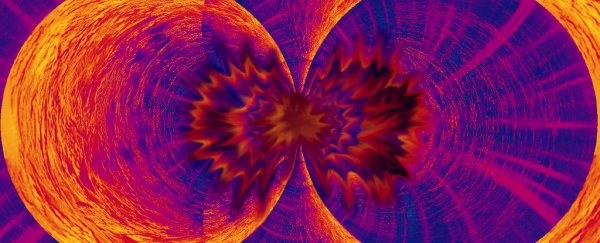A new method for analysing the entanglement of scrambled particles could tell us how the Universe still keeps track of information contained by particles that disappear into black holes. It won't get our quantum information back, but it might at least tell us what happened to it.
Physicists Beni Yoshida from the Perimeter Institute in Canada and Norman Yao from the University of California, Berkeley, have proposed a way to distinguish scrambled quantum information from the noise of meaningless chaos.
While the concept promises a bunch of potential applications in the emerging field of quantum technology, it's in understanding what's going on inside the Universe's most paradoxical places that it might have its biggest pay-off.
"At its core, this is a qubit or qutrit experiment, but the fact that we can relate it to cosmology is because we believe the dynamics of quantum information is the same," says a colleague of Yoshida's, Irfan Siddiqi, who wasn't directly involved in the study.
Black holes are where the extremely small meets the extremely big. Thanks to their intense, matter-squeezing concentrations of mass, in black hole research quantum states become far more important than when we're talking about the behaviours of planets and stars.
One big question that has physicists stumped is what happens to the basic information describing a particle's state once it crosses a black hole's line-of-no-return.
Take an electron, for example. It has charge, mass, momentum … a number of characteristics that make it an electron and not a neutrino or a quark.
There's always wiggle room in how the electron might change, but physics is one hell of a record keeper, so the information about its different states is always there.
If that electron goes into a black hole and gets crammed into an impossibly small space, disconnected from the Universe by a ridiculously steep funnel of space-time, it's hard to say what happens to the information encoding its past and present states.
On one hand, the Universe should still be keeping those account books sharp. On the other, our hypothetical electron is now tumbled in with every other quark, muon, and electron in such a way it's hard to tell what's what. Is the initial information lost in the noise? Or is it simply rearranged?
There is a glimmer of hope for the Universe's accounting. But it's not pretty.
In the 1970s, a relatively young Stephen Hawking suggested the fizz-pop of quantum noise at the edge of the black hole should see some particle twins separate at birth, with one falling into the black hole and the other zipping away into freedom.
Nobody has verified this 'Hawking radiation' as an actual thing, at least not yet. But it does suggest this record keeping might simply occur in an unexpected form.
Information encoded in the way these particle duos reflect one another – referred to as entanglement – could provide a loophole. Given enough entangled information in form of the fleeing particle, the Universe can have its books balanced neatly once again.
"One can recover the information dropped into the black hole by doing a massive quantum calculation on these outgoing Hawking photons," says Yao.
"This is expected to be really, really hard, but if quantum mechanics is to be believed, it should, in principle, be possible."
Key words being 'in principle'. For even a black hole the size of our Sun, the Universe would be a cold, empty place long before enough information is released to describe its heart, making it a dubious possibility at best.
This time frame might be shortened significantly if the information entering a black hole mixes together rapidly enough.
With this in mind, Yoshida and Yao proposed an experimental method based on something called out-of-time-order correlation functions. These 'OTOCs' compare a particle's quantum states based on timing of certain changes.
The mathematics involved are complicated, but they do provide insight into the accounting processes at work, demonstrating a potential way to tell whether a particle's identity is truly indistinguishable from chaos or merely scrambled.
To test their idea, they used a small quantum circuit to scramble quantum states. This constituted a handful of entangled particles that had yet to be formerly measured.
Looking at the way information seems to teleport between the particles once they are measured says a lot about how much of their information is merely jumbled up, and how much is completely lost in the noise.
"With our protocol, if you measure a teleportation fidelity that is high enough, then you can guarantee that scrambling happened within the quantum circuit," says Yao.
In their test case, they came up with a fidelity of 80 percent, implying half of the states were scrambled and the other half broken down irretrievably.
It's a solid proof of concept that could lead to new tools in dealing with the delicate nature of quantum systems. Not to mention an even more exciting prize - tricks like this one might one day tell us if the Universe is keeping track of what's inside black holes.
This research was published in Physical Review X.
